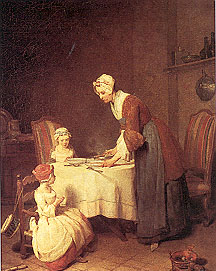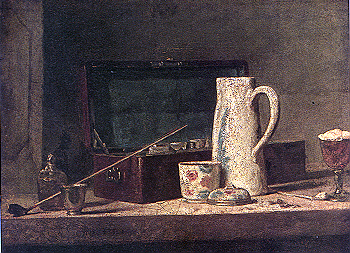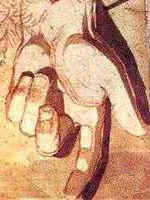Autores : Chardin I
| He works hard to remove the
feeling of a proscenic barrier (...) the scene welcomes the viewer in without ceremony, to
take things just as they are found.91. His canvases tend to avoid priorities(...)91 No single square inch of the painting has been declared unimportant...energising areas of a scene which vision is normally quick to pass over...The canvas is treated as uniformly eventful.92. All forms tend to towards blur...as if what were depicted were the vagaries of the glance in real time.(92). Not tensely vigilant (Cotan, Zurbaran, Caravaggio) but with a sense of having enough time to take the scene in without strain.(93) |
CHARDIN (sin fecha): La Caja del fumador, óleo sobre tela, Paris, Museo del Louvre. En: BRYSON (1990), Looking at the overlooked, Londres, Reaktion, 68. |
| This strategy of
portraying vision in time, as a narrative, and the presence of narrative should bring his
work into the category of anecdotal or history painting-megalography...but there is not
transfiguration or epiphany, the eye moved lightly and without avidity: it is at home.
(93). The blur in Chardin is not simply optical... it is the blur that comes from manual overrride, when the hand takes over from the eye and lets it oof duty.93-4. Se ha dicho que Chardin aplicaba el color con los dedos: sus texturas son mantecosas, casi comestibles; los objetos han sido constantemente tocados: metal pulido, vajillas, mantelerias, mesas...entre la gente y las cosas reina una placida armonia.94-5. Chardin deliberately returns pictorial vision to the ordinary facts of looking.95...its modesty and sense of ease. He seems to paint in his own house, not in a studio. (95). In the work of Chardin, rhopography directly enters into the material world. Its wish is to participate in low-plane reality...It accepts the material fate of living in a creaturely universe, subject to limitation and routine...The degree of its immersion in materiality can be measured in the way it accepts vision anatomically, as a matter of the eye's apparatus, its muscles and lens. Chardin's work assumes that the way the eye naturally sees its world needs no reproof or enhancment.95. In Chardin's genre (...) the division of labour is clear: the women run the house, the man paints. But Chardin works hard to record the domestic scene in such a way that the presence of painting does not disrupt the harmonies it there.166. Chardin's desire to enter the feminine space of domesticity gently and invisibly. 167. |
|
 CHARDIN (1740): La Bendición de la mesa, óleo sobre tela, Museo del Louvre, Paris. En: CALVO (1997), Historia del Arte, Madrid, Santillana, 359. |
There is another aspect to this
dissolution of the barriers between domestic space and the space of the canvas. The
extraordinary textures of Chardin's paint, the play between wt and dry pigment...all
embody a particular attitude of the painter towards his own work.168. He declares that what he does is metier, craft. And the craft of painting is made to seem much like the other kinds of craft presented in his scenes...: they are painted with an insider's understanding.168. He upgrades women's work....Chardin's women are far more locked into domestic chores than, for example, the women in the households of Vermeer or Metsu. (168) They are presented as creatures of labour, always absorbed in the task in hand. 168. Exactly because the images are so perceptually immersed, they are necessarily viewpointed to a single observer. 168. |
| BRYSON (1990): Looking at the Overlooked. Four Essays on Still Life Painting. London, Reaktion Books. | |

